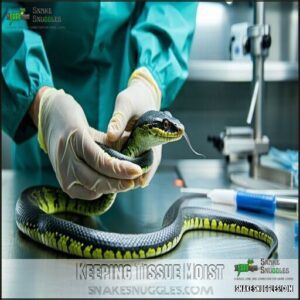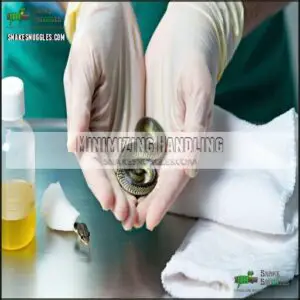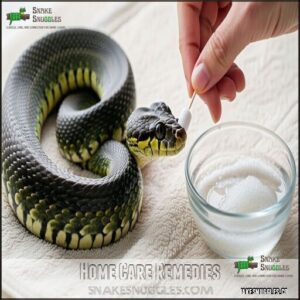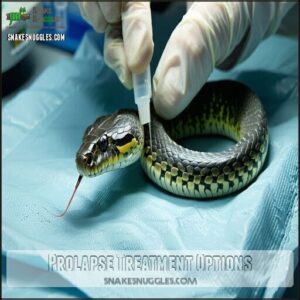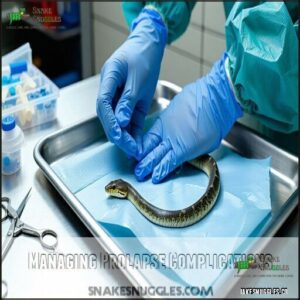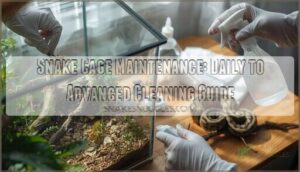This site is supported by our readers. We may earn a commission, at no cost to you, if you purchase through links.
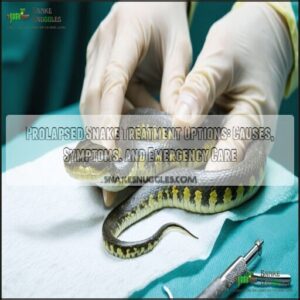
First, keep the exposed tissue moist using clean, damp paper towels or a sugar water solution. Avoid handling your snake too much, as it could worsen the issue.
Common causes include constipation, diarrhea, or egg binding, but only a reptile vet can pinpoint the exact reason.
Treatment options range from gently repositioning the tissue to surgical intervention for severe cases.
Prompt veterinary care is key to avoid complications like infection or tissue death. Proper aftercare and adjusting your snake’s environment can help prevent future prolapses, ensuring a better quality of life.
Table Of Contents
- Key Takeaways
- Snake Prolapse Causes
- Prolapse Symptoms
- Emergency Care Steps
- Veterinary Treatment
- Home Care Remedies
- Preventing Prolapse
- Species-Specific Considerations
- Prolapse Treatment Options
- Managing Prolapse Complications
- Long-Term Recovery
- Frequently Asked Questions (FAQs)
- How should a prolapse be treated?
- What other treatments are available for rectal prolapse apart from surgery?
- What is prolapsed hemipenis in snakes?
- How is cloacal prolapse treated?
- What is the prognosis of cloacal prolapse in reptiles?
- How can a prolapsed swab be treated?
- How to treat prolapse in ball python?
- Why did my snake prolapse?
- How do you treat a cloacal prolapse?
- Can stress contribute to prolapse in snakes?
- Conclusion
Key Takeaways
- Keep the prolapsed tissue moist with sugar water or a water-soluble lubricant and avoid handling the snake too much.
- Contact a reptile vet immediately for treatment options like tissue repositioning or surgery, depending on the prolapse’s severity.
- Address underlying issues like constipation, parasites, or egg binding to prevent recurrence and aid recovery.
- Maintain proper husbandry with balanced diet, hydration, and optimal enclosure conditions to avoid future prolapses.
Snake Prolapse Causes
A snake’s prolapse can often be traced back to problems like constipation, diarrhea, or reproductive issues.
Constipation, diarrhea, or reproductive challenges often lie at the heart of a snake’s prolapse, highlighting the importance of preventative care.
Factors such as parasites, poor diet, or even physical trauma may weaken internal tissues, increasing the risk.
Constipation and Diarrhea
Constipation and diarrhea can strain a snake’s cloaca, leading to prolapse.
Low dietary fiber, poor hydration levels, or an unbalanced gut microbiome increase the risk.
Probiotic use can stabilize digestion, while laxative options may help resolve blockages.
Preventative care, like proper diet and hydration, is key to avoiding these gastrointestinal issues and supporting overall snake health.
Seek timely snake prolapse treatment.
Gastrointestinal Parasites
Gastrointestinal parasites can wreak havoc on snakes, leading to prolapse.
Parasite identification is key to solving the problem.
Watch for these signs:
- Straining during defecation from irritated bowels.
- Weight loss despite eating, a parasite red flag.
- Abnormal stool suggesting infection.
- Secondary infections from untreated parasites.
Stick to deworming protocols and preventative measures for lasting relief.
Feeding a nutritious diet supports healing.
Egg Binding in Females
Sometimes female snakes face egg binding, or dystocia, during breeding.
This happens when eggs can’t pass due to calcium deficiency, poor breeding management, or reproductive strain.
Egg retention can cause oviduct prolapse, leading to snake prolapse.
The pressure builds, causing serious complications if untreated.
Always monitor for breeding complications to prevent egg binding and keep your snake’s reproductive health in check.
Metabolic Bone Disease
Did you know metabolic bone disease can lead to snake prolapse?
A lack of UVB lighting and dietary imbalance weakens muscles, affecting calcium absorption.
Muscle weakness and skeletal deformities can strain their body, increasing prolapse risks.
Proper lighting, a balanced diet, and early intervention are essential snake health issues to tackle for effective reptile prolapse treatment and overall reptile health.
Prolapse Symptoms
When your snake has a prolapse, one of the first things you’ll notice is tissue extending from its cloacal opening.
Other signs include frequent straining or discolored tissue, which can mean serious damage or even necrosis.
Visible Tissue Extension
Spotting visible tissue extending from the cloaca is essential for identifying a prolapsed cloaca or hemipenes in snakes.
Watch for moist, pink, or reddish tissue. Black or darkened areas suggest tissue damage or necrosis.
Here’s what to note:
- Tissue Color: Light pink to dark indicates health or damage.
- Extension Size: Larger sizes need urgent care.
- Prolapse Location: Helps determine treatment.
Excessive Straining
Excessive straining stresses the cloacal tissue, weakening it over time.
Common snake prolapse causes include diet and straining issues, parasites, uroliths, and egg-binding strain.
Trouble passing waste or eggs often signals problems. Spot these symptoms early to prevent complications.
One key step is to understand snake prolapse causes.
| Cause | Effect on Straining | Risk of Prolapse | Prevention Tip | Severity |
|---|---|---|---|---|
| Parasites | Inflames GI tract | High | Deworm regularly | Moderate |
| Egg Binding | Pressure on cloaca | Very High | Balanced breeding care | Severe |
| Uroliths | Painful urination | Severe | Proper hydration | Severe |
| Constipation | Blocks waste passage | High | Fiber-rich diet | Moderate |
| Poor Nutrition | Weakens body tissues | Moderate | Balanced feeding plans | Low-Moderate |
Tissue Necrosis
Necrosis can happen if prolapsed tissue isn’t treated quickly.
You’ll notice dark, discolored tissue indicating cell death.
Severity assessment is essential—untreated necrosis leads to permanent tissue damage.
Keep the area clean and moist, and seek veterinary care immediately for necrosis prevention and treatment.
Early attention helps preserve tissue viability, reduces long-term effects, and prevents complications like infections or wound management challenges, ensuring permanent tissue damage is avoided.
Emergency Care Steps
When a snake experiences a prolapse, acting quickly can make a big difference.
Focus on keeping the tissue moist, minimizing handling, and reducing straining until you can get to a vet.
Keeping Tissue Moist
To prevent tissue damage during snake prolapse treatment, keeping tissue moist is vital. Use a water-soluble lubricant or sugar water soaks to maintain tissue viability.
Proper treatment may require specialized snake lubricants.
Follow these steps:
- Apply sugar solutions to reduce swelling.
- Maintain enclosure humidity levels.
- Gently clean with antiseptic options.
- Avoid using petroleum-based products.
- Regularly check for moisture retention.
Minimizing Handling
Reducing stress is essential when treating snake prolapse.
Handle your snake as little as possible.
If necessary, guarantee gentle techniques and safe transport using a soft, clean container.
Avoiding injury is key—don’t tug or push.
Use a sterile lubricant to keep tissues moist.
Less handling means less strain, helping recovery.
| Practice | Importance | Example |
|---|---|---|
| Gentle Handling | Avoids injury | Use soft hands, no force. |
| Stress Reduction | Speeds recovery | Keep the snake calm. |
| Safe Transport | Minimizes straining | Use damp paper towels. |
| Handling Frequency | Reduces tension | Handle only when necessary. |
Reducing handling frequency is crucial as it reduces tension.
Handle your snake only when necessary to minimize straining.
By following these guidelines, you can help your snake recover from prolapse more effectively.
Reducing Straining
Gentle enclosure modifications can reduce straining during a prolapse.
Remove sharp or large items to minimize stress and injury.
Focus on dietary fiber and hydration importance to keep digestion smooth.
Regular exercise promotion helps too.
For severe cases, prolapse reduction may require veterinary care.
Preventative deworming also lowers risks, making treating snake prolapse easier with prompt action and proper guidance.
Veterinary Treatment
When your snake experiences a prolapse, a veterinarian is the best person to handle it properly.
They’ll focus on safely repositioning the tissue, addressing damage, and treating any underlying causes.
Reduction of Prolapse
Prolapse reduction in snakes often starts with manual repositioning of the tissue using hypertonic solutions to reduce swelling.
Sedation benefits both the snake’s comfort and the vet’s ability to work safely.
After reduction, suture placement may secure tissues, aiding recovery.
Post-reduction care like maintaining humidity and monitoring for infection is critical for successful snake prolapse repair and healing.
Surgical Intervention
Surgical treatment for snake prolapse often involves anesthesia and careful techniques like cloacoplasty.
Surgeons evaluate tissue viability and use sutures to repair damage. Here’s what happens:
- Intestines or organs are repositioned safely.
- Severe cases might need hemipene amputation or bladder stone removal.
- They address post-op complications with precision.
Surgical alternatives exist, but risks depend on the snake’s condition.
Post-Operative Care
After surgery, snake prolapse aftercare is essential.
Monitor sutures daily for infection, keeping the area clean and dry.
Pain management and antibiotic use help prevent discomfort and complications.
Limit your snake’s activity to aid healing.
Check for swelling or redness around the incision.
Consistent posttreatment care, including incision monitoring, helps guarantee a smooth recovery and reduces the risk of recurring issues, ensuring smooth recovery.
Home Care Remedies
You can try a few safe remedies at home to manage a prolapse before heading to the vet.
Simple steps like sugar water soaks and applying petroleum jelly can help reduce swelling and protect the tissue temporarily.
Sugar Water Soaks
Sugar water soaks can help reduce tissue swelling during snake prolapse treatment. Prepare a hypertonic solution with warm (not hot) water and dissolve sugar to create the right soak concentration.
For related product options, explore online resources.
Focus on these steps:
- Use lukewarm Soak Temperature.
- Limit Soak Duration to 20 minutes.
- Repeat Soak Frequency twice daily.
- Monitor for reduced tissue edema.
- Explore Soak Alternatives like saline solutions.
Petroleum Jelly Application
Using petroleum jelly can provide temporary protection for prolapsed tissue during snake care.
Its lubrication benefits help prevent adhesion and reduce irritation. Gently apply a thin layer with clean hands or a cotton swab.
For safer alternatives, consider using a specialized reptile product.
Avoid using it if there are signs of excessive swelling or necrosis. Always follow up with veterinary care to confirm proper snake prolapse treatment.
Mild Prolapse Resolution
If you spot mild snake prolapse, early intervention is your best friend.
Sometimes, spontaneous reduction occurs with gentle care. Keep the tissue moist with a water-soluble lubricant or sugar treatment to reduce swelling.
Monitor progress while practicing home management. Avoid manual replacement unless trained.
Know when to escalate—consult a vet promptly if it doesn’t improve. A key step involves keeping tissue moist to prevent damage, which is crucial for successful treatment.
Preventing Prolapse
You can prevent prolapse by maintaining proper humidity, offering a balanced diet, and keeping your snake well-hydrated.
Regular vet check-ups are essential to catch potential issues early and guarantee your snake stays healthy.
Proper Humidity and Temperature
Stable humidity levels and consistent temperature gradients are game-changers for preventing snake prolapse.
Use thermostats to regulate basking spots at 90-95°F while keeping night temperatures around 75°F.
Improper conditions dry out tissue moisture, stressing your snake, and making treatment options less likely down the road is not the goal, instead, invest in hygrometers to monitor humidity—55-65% works wonders.
These small tweaks provide comfort and reduce risks.
Balanced Diet and Hydration
A healthy diet and hydration keep your snake’s body in top shape, reducing prolapse risks.
Focus on proper meal size, hydration methods, and supplementation needs to support nutrient absorption and MBD prevention.
For ideal snake care:
- Offer clean, fresh water daily.
- Provide a varied, balanced diet for snake health.
- Use feeders appropriate to your snake’s size.
- Add calcium supplements if needed.
Regular Veterinary Check-Ups
Regular veterinary checkups are a must to keep your snake in top shape.
A reptile vet guarantees parasite screening, dietary assessment, and early detection of health issues like snake prolapse.
Preventative care is key—small problems caught early save hassle later.
Plus, exotic pet vets offer specialized advice to improve health monitoring, boosting your snake’s chances of a long, comfortable life.
Species-Specific Considerations
Each reptile species has unique needs, so their prolapse care isn’t one-size-fits-all.
Understanding these differences can help you address issues like dehydration in ball pythons or parasites in bearded dragons more effectively.
Ball Pythons and Dehydration
Ball pythons often struggle with dehydration, which increases their risk of snake prolapse.
Watch for shedding problems or sunken eyes—common signs of dehydration. Make certain steady water availability and proper humidity levels (50-60%).
Providing soaking benefits in lukewarm water helps keep them hydrated. Recognizing dehydration early and addressing it’s key to effective snake care and preventing prolapse in these reptiles.
Bearded Dragons and Parasites
Bearded dragons often face prolapse due to common parasites like coccidia and nematodes.
Parasite identification through fecal testing is key. Left untreated, parasites can cause straining and long-term effects on health.
Preventative measures, like routine deworming and proper hygiene, help avoid issues. If prolapse occurs, seek reptile vet care immediately to explore effective prolapse treatment options and guarantee your dragon recovers with proper hygiene.
Turtles and Gastrointestinal Issues
If poor diet or parasite problems can harm bearded dragons, turtles aren’t far behind.
Their gastrointestinal issues often stem from inadequate Turtle Gut Health care and hydration gaps. Parasites and a wrong diet lead to prolapse risks. Optimal humidity levels are also critical for their well-being.
For turtles, focus on these:
- Parasite Prevention steps.
- Diet Impact.
- Hydration Importance.
- Shell Issues.
- Immediate reptile vet care for signs.
Prolapse Treatment Options
Treating a snake’s prolapse requires quick action and often professional care. Options include using a pessary, surgical repair, or exercises to strengthen surrounding tissues, depending on the severity.
Vaginal Pessary
A vaginal pessary, though effective for prolapse in some animals, isn’t commonly used for snakes due to anatomical differences.
Pessary insertion isn’t practical for reptiles, but understanding pessary types can guide discussions on prolapse treatment options.
Veterinary care often focuses on medical approaches like reducing swelling or surgical incision, and it is essential to always consult professionals for alternatives and to minimize pessary complications.
Surgery and Sutures
Snake prolapse surgery typically involves a cloacoplasty where prolapsed tissues are repositioned and secured using sutures.
The surgeon verifies the tissue is viable before repair. Choosing the right suture materials minimizes post-surgical complications.
Anesthesia risks are managed carefully, with pain management guaranteeing the snake’s comfort during recovery.
Proper care of the surgical incision helps prevent infection and aids successful snake prolapse repair.
Kegel Exercises
Kegel exercises aren’t for snakes, but strengthening their "pelvic floor" is still essential.
Focus on reptile anatomy instead—proper hydration, diet, and calcium can improve muscle tone, indirectly helping prolapse management.
While Kegel techniques fit humans, reptiles benefit from customized prolapse treatment options like reducing strain.
Natural remedies and consistent care trump traditional “exercise frequency” for these unique creatures, emphasizing the importance of customized care.
Managing Prolapse Complications
Managing prolapse complications means addressing issues like infections, recurring cases, or delayed care right away.
If you don’t act quickly, these problems can cause permanent damage or even be life-threatening for your snake.
Infection and Necrosis
Infection control is essential for snake prolapse complications. Exposed tissue risks infection and necrosis fast, threatening tissue viability.
To prevent this:
- Keep tissue moist with sterile saline.
- Use antibiotics for infection prevention.
- Remove necrotic tissue surgically if needed.
- Monitor swelling and discoloration closely.
- Seek veterinary care promptly for necrosis treatment.
Ignoring signs risks worsening the condition.
Recurring Prolapse
When prolapse complications return, it’s frustrating, but addressing persistent causes is key.
Recurrence prevention often demands surgical revision for recurring swelling or repositioning tissues securely. Lifestyle adjustments, like improved diet and enclosure conditions, reduce future prolapse risks.
As detailed on a useful site, gastrointestinal parasitism strains the cloaca, leading to prolapse. Preventative measures, including parasite control and hydration, support a better long-term prognosis.
Avoiding potential prolapse recurrence requires patience, monitoring, and consistent care to improve your pet’s health.
Delayed Veterinary Care
Waiting too long for professional veterinary care can make snake prolapse much harder to treat.
The tissue dries out, increasing severity and complication likelihood, while treatment costs soar.
Mortality risks rise too, as infections set in or necrosis takes hold.
Emergency care and timely veterinary attention improve the prognosis and reduce long-term damage.
Don’t delay—it’s a decision that impacts your snake’s survival.
Long-Term Recovery
You’ll need to focus on consistent care to support your snake’s recovery and prevent future problems.
This includes monitoring their health, addressing the original cause of the prolapse, and providing a stable, stress-free environment.
Monitoring and Follow-Up
Keep a close eye on your snake after treatment.
Follow-up care, like weight monitoring and behavioral changes, helps prevent recurrence.
Stick to medication instructions, and clean the area regularly for proper wound care.
Schedule veterinary checkups to track the long-term prognosis.
Long-term monitoring guarantees your snake’s condition stays stable, offering a safer, healthier future with fewer surprises, and a better future.
Addressing Underlying Causes
Addressing underlying causes is key to long-term recovery from snake prolapse. Focus on resolving issues like improper diet or disease.
Evaluate your pet’s care routine, then:
- Treat infections promptly with vet-recommended medicines.
- Implement parasite control to ease gastrointestinal strain.
- Correct metabolic bone disease (MBD) through calcium and UVB lighting.
- Reduce stress by improving handling and husbandry practices.
Tackle these factors to prevent recurrence and ensure a successful recovery by addressing the root causes, including metabolic bone disease.
Maintaining Optimal Environment
To help your snake recover, focus on a stable environment.
Maintain proper temperature gradients (75-95°F) and humidity levels (55-65%).
Use an enclosure sized for easy movement with safe substrate choices.
Keep clean water available and reduce environmental stressors, like loud noises.
Enrichment items can reduce boredom and support healing.
| Aspect | Recommendation |
|---|---|
| Temperature Gradients | 75-95°F |
| Humidity Levels | 55-65% |
| Enclosure Size | Proportional to snake size |
| Substrate Choices | Non-irritating, easy-to-clean |
| Water Availability | Provide fresh daily |
Frequently Asked Questions (FAQs)
How should a prolapse be treated?
Gently keep the tissue moist with water-soluble lubricant or sugar solution to prevent damage.
Avoid pushing it back yourself.
Minimize handling, provide warmth, and contact a reptile vet immediately for proper diagnosis and treatment.
What other treatments are available for rectal prolapse apart from surgery?
Sometimes, less is more—treat rectal prolapse by reducing swelling with a sugar solution or water-soluble lubricant.
Temporary stitches might help, but addressing underlying health issues, like constipation or infection, is often the real cure.
What is prolapsed hemipenis in snakes?
A prolapsed hemipenis in snakes happens when one or both reproductive organs protrude from the cloaca and can’t retract.
It’s often caused by injury, infection, or excessive breeding activity.
Immediate veterinary care is essential.
How is cloacal prolapse treated?
It’s ironic how something as small as stress can lead to big problems like a cloacal prolapse.
Keep it moist with sugar water or saline, minimize handling, and quickly get a reptile vet involved.
What is the prognosis of cloacal prolapse in reptiles?
The prognosis depends on prompt treatment and the damage’s severity.
With quick veterinary care and proper management, most reptiles recover well.
Delayed treatment increases risks of infection, tissue necrosis, or recurrence, complicating recovery substantially, which underscores the importance of quick veterinary care.
How can a prolapsed swab be treated?
Imagine spotting a small, pink balloon peeking out.
Keep it moist with sterile saline, avoid pushing it back in, and get your snake to a reptile vet quickly.
Delays can cause serious complications.
How to treat prolapse in ball python?
Keep the tissue moist with sugar water or saline, reduce swelling gently, and consult a reptile vet immediately.
Avoid handling too much.
Creating a warm, clean enclosure helps reduce stress while seeking treatment.
Why did my snake prolapse?
A snake prolapse often stems from straining caused by constipation, parasites, or egg binding.
Poor diet, injuries, or stress can weaken tissues.
It’s like life’s pressure cooker—too much strain, and something gives.
How do you treat a cloacal prolapse?
Gently keep the tissue moist with a water-soluble lubricant and seek immediate veterinary help.
Avoid pushing it back yourself to prevent damage.
Maintain your snake in a clean, stress-free environment until medical care arrives, and remember to keep the tissue moist.
Can stress contribute to prolapse in snakes?
Over 60% of reptile health issues stem from husbandry problems, and stress often plays a big role.
It weakens your snake’s immune system, increasing vulnerability to prolapse by causing straining, digestive issues, and poor muscle control, which can be attributed to stress.
Conclusion
Dealing with a prolapse in your snake might feel like the end of the world, but it’s manageable with prompt action and proper care.
Focus on keeping the exposed tissue moist and getting your pet to a reptile vet quickly.
Prolapsed snake treatment options, like repositioning or surgery, depend on the severity but can save your snake’s life.
Long-term recovery requires monitoring, habitat adjustments, and addressing underlying causes to ensure your scaly friend thrives.
Stay proactive to guarantee a successful outcome.





